

Do you want a huge amount of usable display space, but don’t want to hassle with a double-monitor setup? If so, an ultrawide monitor is the ticket. Ultrawide monitors have a wider display panel that provides an immersive experience and far more screen real-estate than your average widescreen.
I’ve tested a bunch of ultrawide monitors in order to name the best picks in various categories ranging from those optimized for gaming to those best for professional use. Below you’ll find a curated list of my favorites in each category. I describe my evaluation process for monitors at the bottom of this article, or for even more details, see the article on how we test monitors for PCWorld.
If you’re still on the fence about whether an ultrawide is the right choice for you, see PCWorld’s article on whether ultrawide monitors are worth it to have all your questions answered.
You can find even more monitor recommendations in our roundup of the best monitors.
Updated April 26, 2024: See our recent review of the BenQ PD3420Q. This ultrawide was a little too niche to make our list of recommendations, but it’s an interesting choice for creative professionals, offering an accurate image, multiple color modes, an easy-to-use menu system, and lots of connectivity.
Alienware AW3423DWF – Best ultrawide monitor
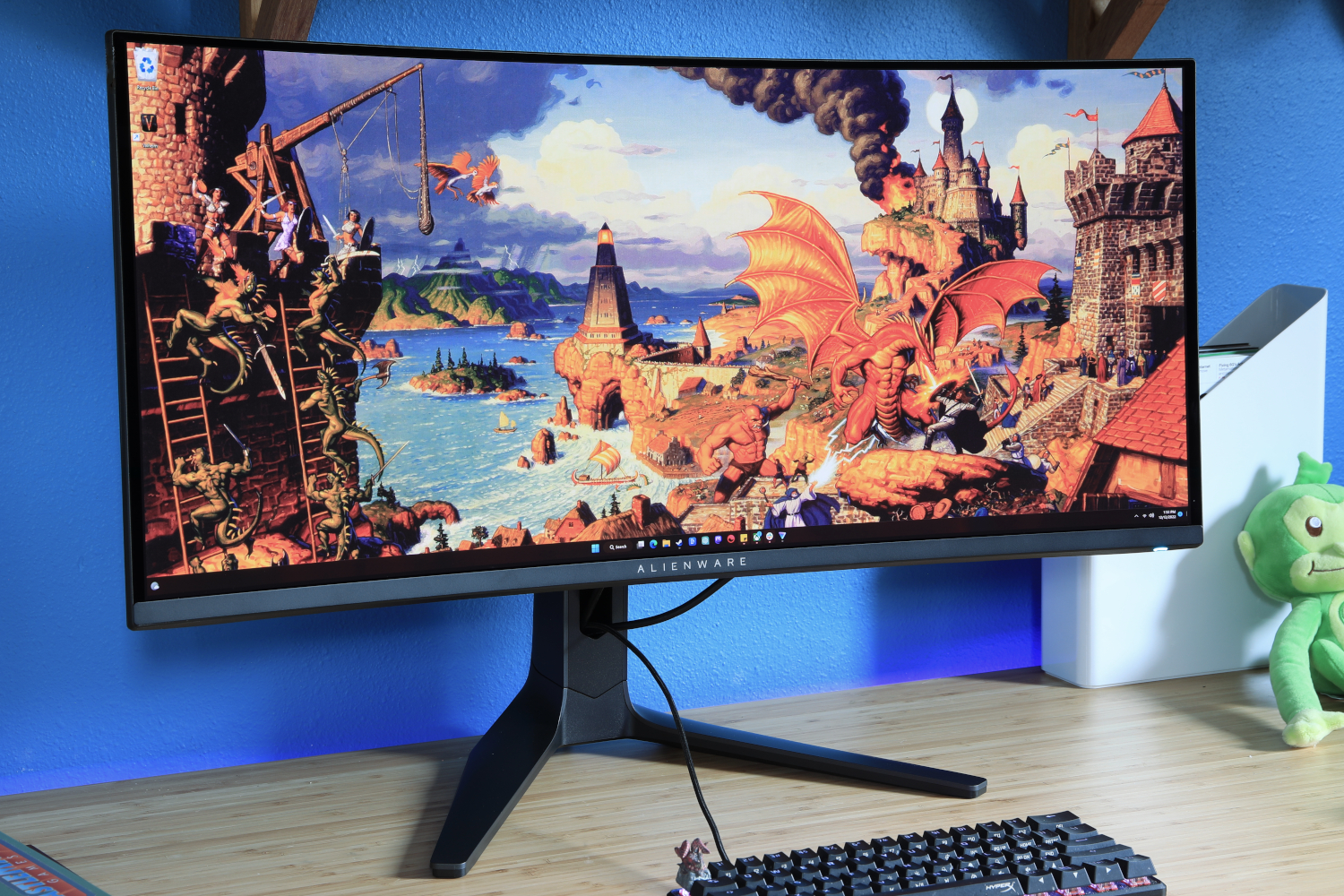
Pros
Excellent contrast ratio Top-notch color gamut and accuracy Great motion clarity Respectable HDR performance Extremely competitive price
Cons
Stand is a bit too large No USB-C Maximum HDR brightness is lackluster Price When Reviewed:$1,099.99Best Prices Today:$904.95 at Walmart$999.99 at Dell$1,099.99 at Amazon
The Alienware AW3423DWF is a legendary monitor. It packs the incredible contrast and realism of OLED in a 34-inch widescreen panel, yet it’s priced at just $1,099. That’s not inexpensive, but it’s better value than other OLED monitors available right now.
Image quality is where it stands out. It delivers a vivid, immersive, rich experience with deep black levels and bright highlights, which are enhanced by the display’s glossy finish. Movies and games seem nearly three-dimensional—as if you’re looking through a window, not staring at a monitor.
What’s the catch? The monitor is not bright, especially in SDR, so it’s a bad choice for a brightly lit room. We also noticed the OLED panel has trouble rendering small fonts smoothly. These are minor issues, though, and shouldn’t trouble most owners.
This monitor targets gamers, so it offers an enhanced refresh rate of up to 165Hz and supports AMD FreeSync Premium Pro for smooth frame pacing in games. However, its excellent image quality will be impressive in everyday use, as well.
It has good connectivity, with two DisplayPort inputs and one HDMI, as well as a USB-A hub with four ports. There’s even a healthy range of calibration options that help demanding owners dial in the image to their personal specifications.
Read our full Alienware AW3423DWF review
Gigabyte GS34WQC – Best budget ultrawide monitor
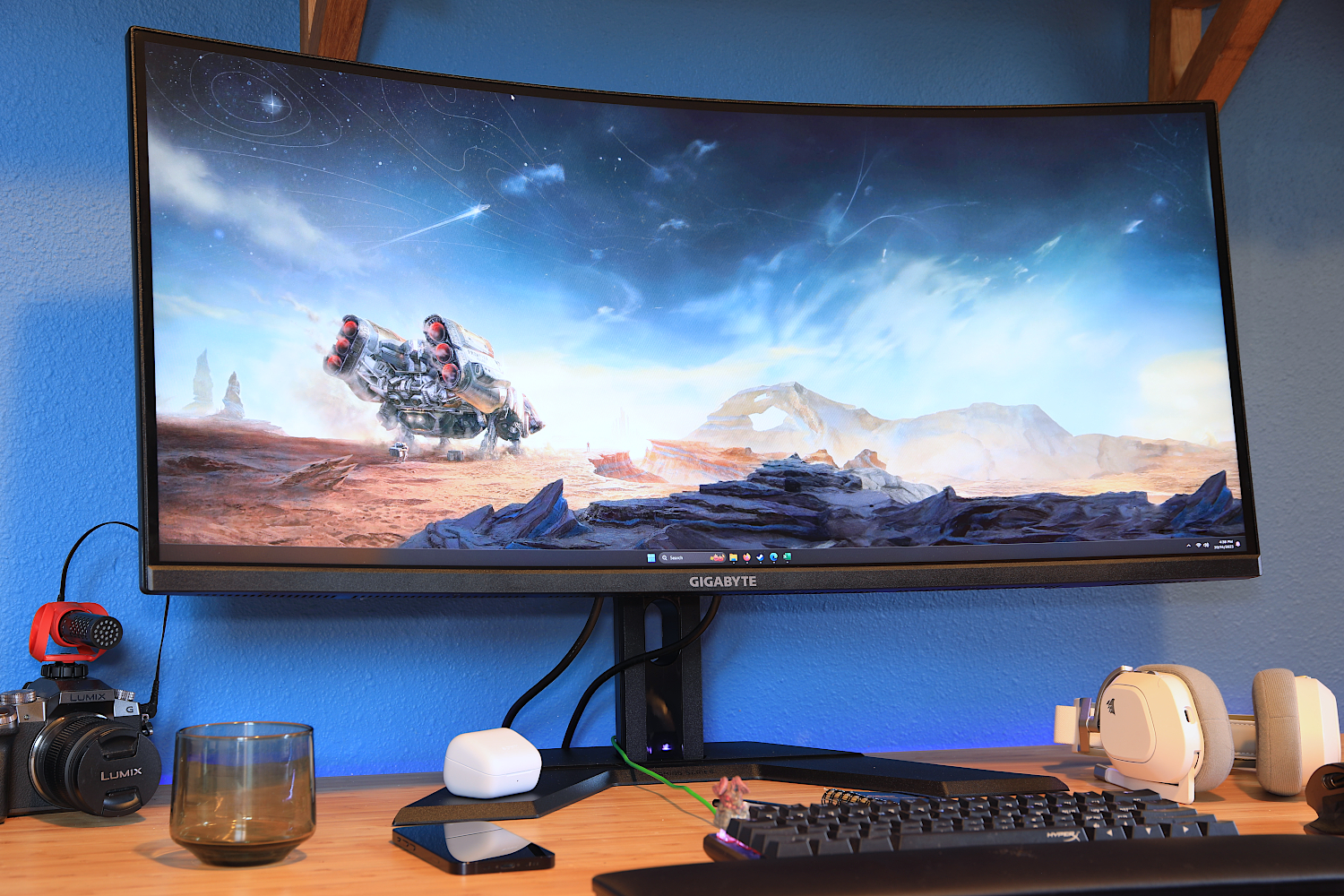
Pros
Plenty of connectivity and menu options Good contrast ratio Solid color performance Up to 144Hz refresh rate with good motion clarity
Cons
Stand setup uses screws instead of clip mechanism Modest maximum brightness HDR is supported but lackluster Price When Reviewed:$329.99Best Prices Today:$297.99 at Best Buy
The Gigabyte GS34WQC is a great budget ultrawide monitor. It has a sharp 34-inch ultrawide display panel that provides 3440×1440 resolution. It also delivers strong scores across contrast and color accuracy that frequently rival more expensive displays. The result is image quality comparable to many monitors sold for twice as much.
Motion clarity is strong, as well. The monitor has a 120Hz refresh rate, which can be overclocked to 135Hz, and supports AMD FreeSync for smooth and consistent gameplay. Camera pans deliver good detail and fast objects are easy to track. There’s better monitors for motion clarity, of course (similarly priced widescreen monitors can hit a refresh rate of 240Hz), but the GS34WQC’s results are solid for the price.
Gigabyte’s GS34WQC relies on a functional, though basic, design. The monitor’s build quality is commendable and includes a robust stand. Assembling the stand is a hassle, as you must manually attach four screws. Most competitors have a clip-in stand that can be assembled without tools. Fortunately, the GS34WQC has an intuitive menu system with extensive customization options that help gamers customize the visuals to their preference.
But the GS34WQC’s best trait is undeniably its price. The monitor carries an MSRP of $330 and can be had for even less on sale. It’s not the least expensive ultrawide available but it easily beats the image quality of its less expensive ultrawide competitors.
Read our full Gigabyte GS34WQC review
LG Ultragear 34GN850 – Best midrange ultrawide monitor for gamers
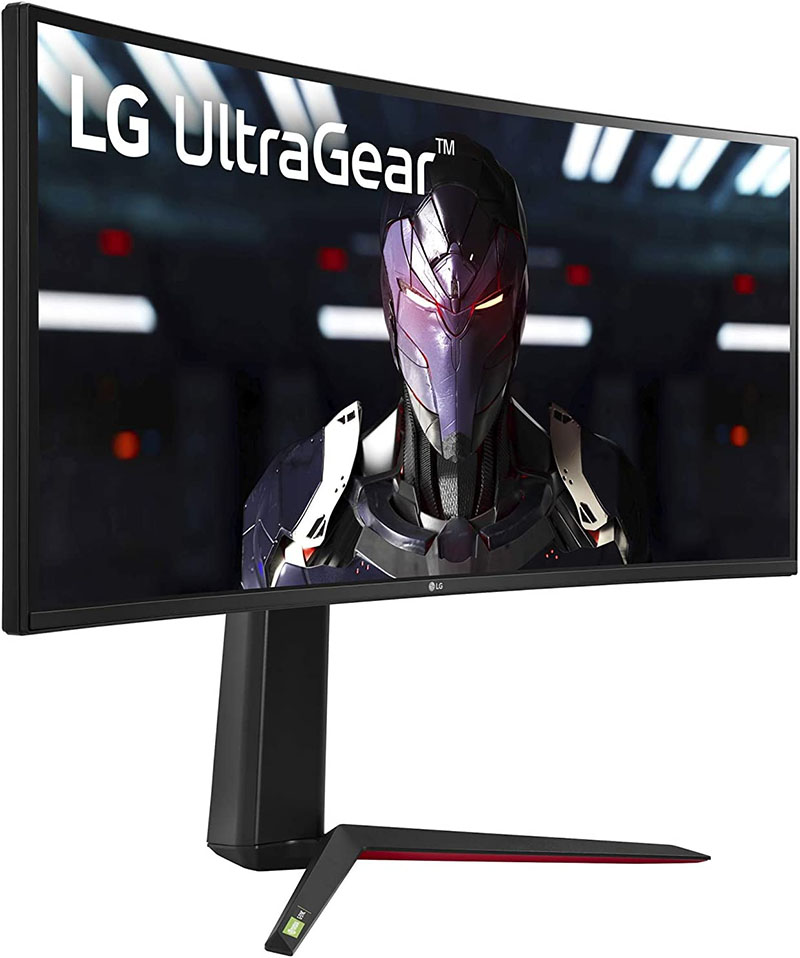
Pros
21:9 panel with a 34-inch screen Curved monitor Impressive gaming performance Ergonomic adjustment options
Cons
Only average power consumption Expensive Price When Reviewed:999.99Best Prices Today:$569.99 at Amazon$750 at LG
The LG Ultragear 34GN850-B, released in 2020, was once the king of ultrawide gaming. It was dethroned by Alienware’s AW3423DWF—and as a result LG has slashed the price. Originally $999.99, this monitor is now available for $699.99 (and sometimes less).
That’s great news. Although surpassed by the Alienware, LG’s Ultragear 34GN850-B is an attractive monitor with excellent color performance, good image clarity, and a bright, vivid picture. It has an enhanced refresh rate of up to 144Hz (with a 160Hz overclocked mode) and supports both AMD FreeSync and Nvidia G-Sync for smooth gameplay.
Its weakness? Contrast. The IPS panel scores lower in contrast than other monitors on this list, including the Asus ProArt PA348CV, which also has an IPS panel. The image can look hazy in darker scenes.
Connectivity is respectable with two HDMI ports, one DisplayPort, and two-port USB-A hub for connecting wired peripherals. The monitor also retains many of the features that would be expected of a high-end monitor including a sturdy ergonomic stand and attractive design.
Read our full LG Ultragear 34GN850 review
Dell U4025QW – Best 5K ultrawide monitor
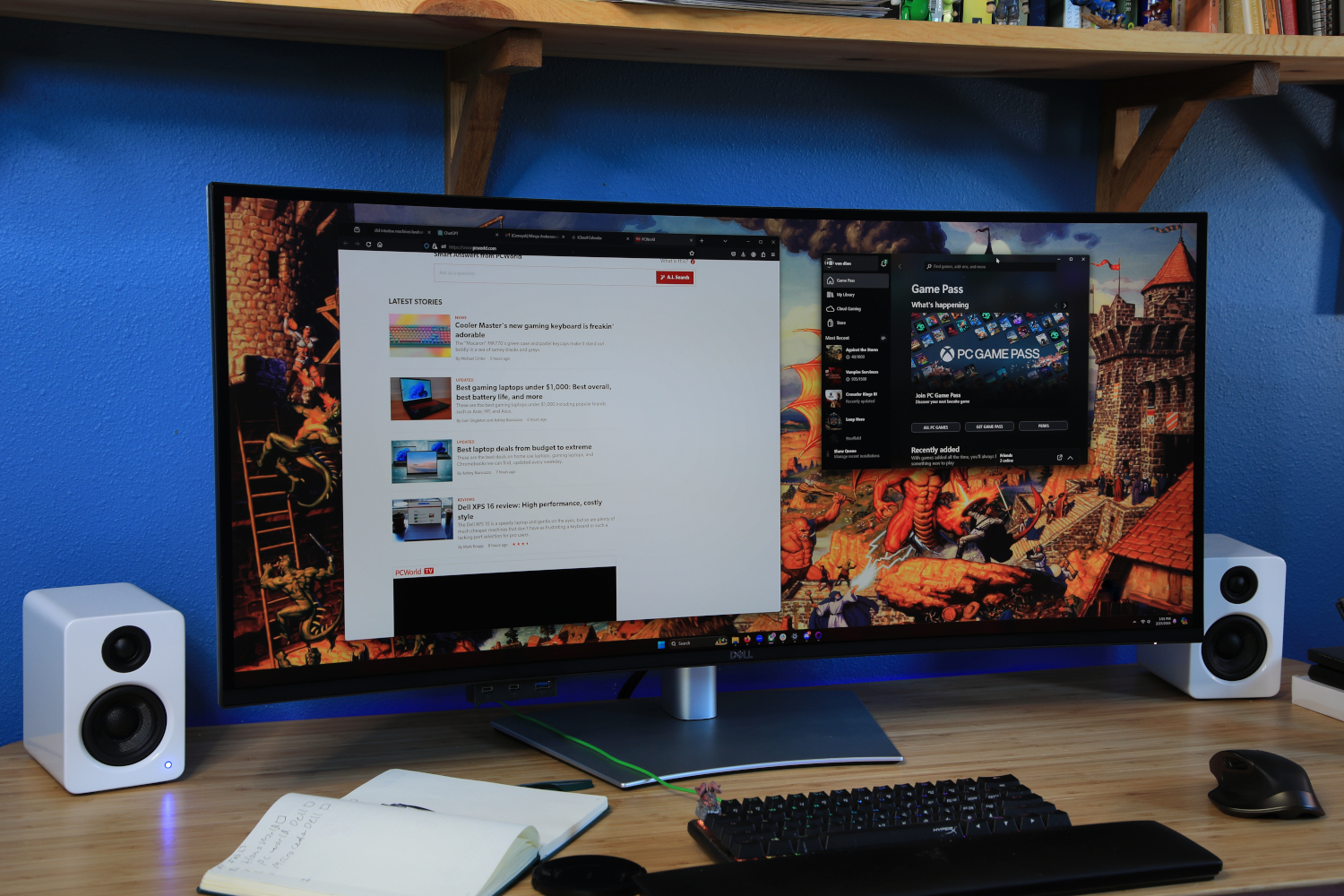
Pros
Sharp, vibrant, color-accurate 5K display Incredible connectivity including Thunderbolt, Ethernet Long list of menu options and features 120Hz refresh rate is impressive at this resolution
Cons
Stand is wobbly and hard to adjust Contrast ratio remains far short of OLED competitors HDR doesn’t look its best Extremely expensive Price When Reviewed:$2,399.99
The Dell Ultrasharp U4025QW is an excellent ultrawide monitor with a vast 40-inch display and 5K resolution that ensures every detail is sharp and defined. But it’s not just about its size and clarity; it’s packed with features, too.
Visually, the U4025QW is a treat, offering unparalleled sharpness and an expansive workspace that enhances productivity and elevates entertainment. The monitor’s impressive 120Hz refresh rate is a rare find at this resolution, ensuring smooth motion on the Windows desktop and in games. It even has an IPS Black display panel, which improves contrast and delivers a more realistic, immersive image.
The U4025QW’s connectivity is extensive. It has Thunderbolt, Ethernet, HDMI, and DisplayPort, as well as a USB hub that includes multiple downstream USB-A and USB-C ports. The monitor’s menu options and settings provide significant image quality control as well as useful features like picture-in-picture and picture-by-picture modes.
That’s not to say it’s perfect. The monitor’s stand isn’t as robust as it should be, and while the contrast ratio of IPS Black is commendable, it can’t rival OLED. But the most serious downside is the price, which soars close to $2,000. But if you want a big, sharp monitor to serve as the focal point for a desktop command center, the Dell Ultrasharp U4025QW is worth it.
Read our full Dell U4025QW review
Asus ProArt PA348CGV – Best ultrawide monitor for professionals
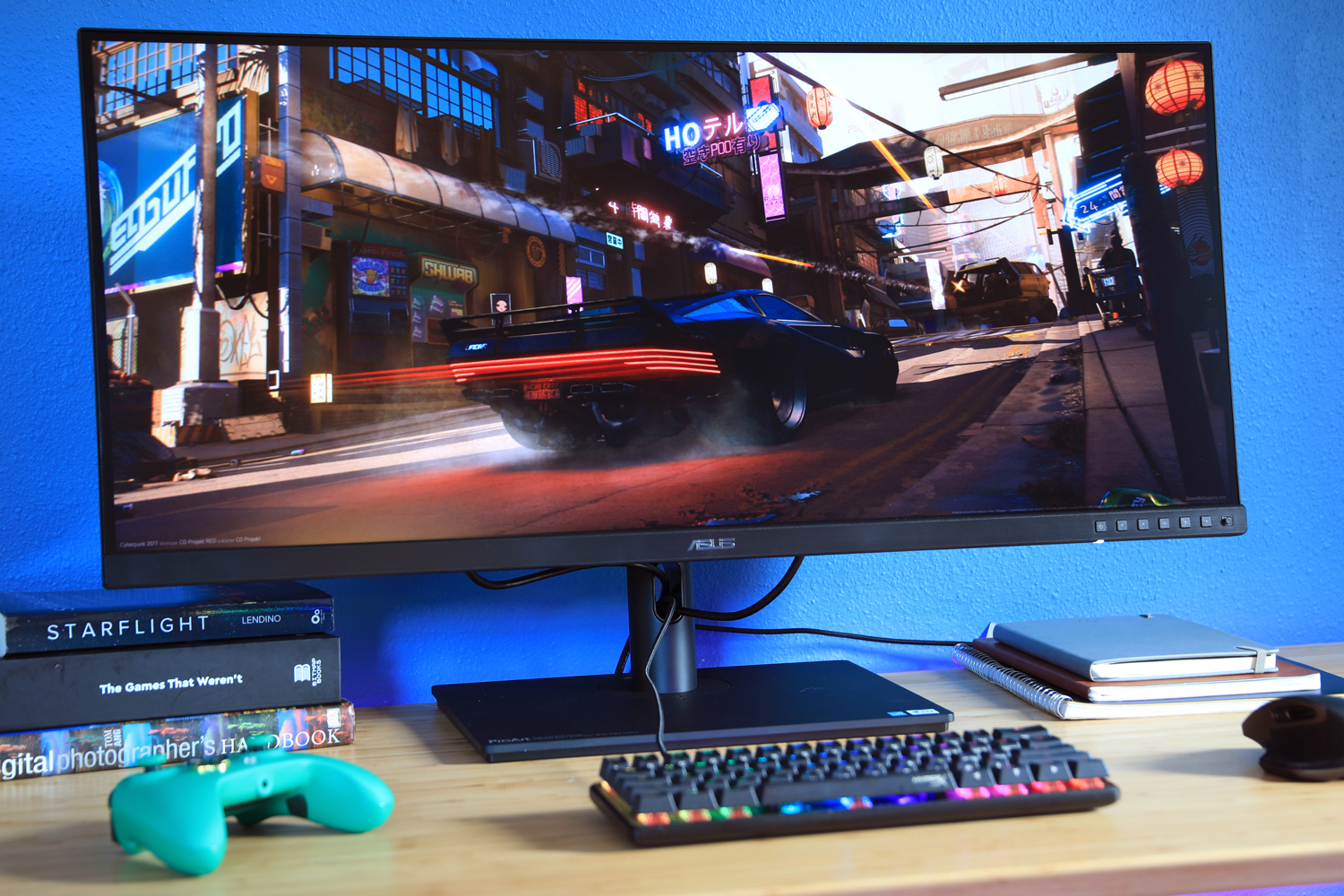
Pros
Excellent SDR image quality Sturdy, hefty design Wide range of customization 120Hz refresh rate
Cons
USB-C hub lacks video-out or ethernet HDR is merely passable Price When Reviewed:729.99Best Prices Today:$679 at B&H$699 at B&H Photo$899.99 at Amazon
The Asus ProArt PA348CV surpassed our expectations. Priced at just $729.99, it’s towards the low end of pricing for a professional ultrawide display—yet its performance is near the top of the pack.
This monitor has a wide color gamut, excellent color accuracy, and a virtual buffet of image-quality calibration features that let users precisely tune the image. It’s also a bright and vivid monitor, making it easy to use in nearly any office. Admittedly, it doesn’t set any records in image quality tests—but it ties or comes close to alternatives that are hundreds of dollars more expensive.
Asus throws in a useful USB-C port that supports DisplayPort Alternate Mode and delivers 90 watts of USB Power Delivery. It also drives a USB-A hub with four downstream ports. Additional video connectivity includes two HDMI and one DisplayPort for a total of four input options.
Surprisingly, Asus throws in an enhanced refresh rate up to 120Hz. It’s not sold as a gaming monitor, but it can handle gaming well enough. That’s good news if you need one home office monitor for both work and play.
Read our full Asus ProArt PA348CGV review
Corsair Xeneon Flex – Best big-screen ultrawide monitor
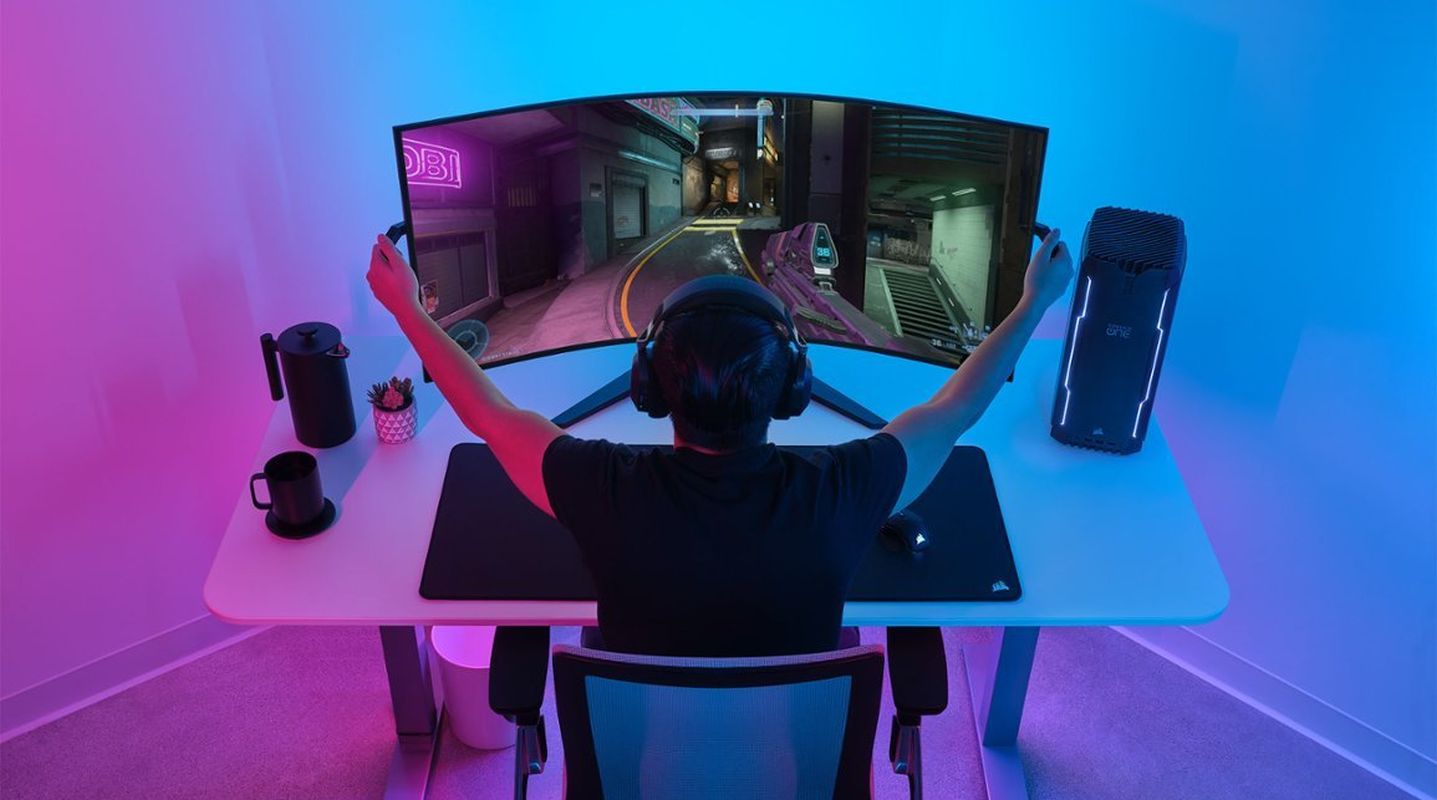
Pros
Incredibly immersive gaming experience Huge 45-inch ultrawide OLED panel can be adjusted from flat to 800R curve to suit your setup Exceptional image quality, contrast, color performance, and HDR Elite motion clarity on a 240Hz panel Abundant connectivity with USB-C hub and power delivery options It made four people who walked into my office stop and say “WHOA” like Keanu Reeves
Cons
Poor text clarity and general sharpness for productivity work Very expensive No swivel or tilt options, stand can’t be replaced Bending mechanism feels clunky and mildly terrifying at first Enabling HDR mutes desktop contrast and vibrancy Price When Reviewed:$2,000Best Prices Today:$1599.99 at Walmart$1700.99 at Corsair$1,779.21 at Amazon
Want a monitor that takes immersion to a new level and outshines your friend’s measly 34-inch ultrawide? The Corsair Xeneon Flex 45WQHD240 is for you.
The Xeneon Flex 45WQHD240 takes immersion to a new level, outshining pedestrian 34-inch ultrawides. It’s an incomparable way to enjoy visually stunning games.
The 45WQHD240 has an extremely high contrast ratio and a wide color gamut. Maximum brightness is high (for OLED) as well, which is a benefit if you want to play games with HDR turned on. The monitor’s 240Hz refresh rate and low pixel response times provide top-notch motion clarity. Even its modest 3440×1440 resolution may be seen as a benefit. While it does soften the image, it also reduces the strain on your GPU, making it possible to enjoy high-quality settings on midrange hardware.
But there is even more to the Xeneon Flex, which is hinted at in its name: The display features a unique flexible OLED panel that can be adjusted from a completely flat position to an impressive 800R curvature, one of the tightest curves available in a monitor. You adjust the curve manually, using the handles located on each side of the display. The flexibility is useful if you enjoy a wide variety of game genres (you may want it flat while playing Civilization IV but curved in Cyberpunk 2077).
The Corsair Xeneon Flex features a robust and stable stand with integrated ports including USB-C. The stand doesn’t, however, offer height adjustment. With a retail price of nearly $2,000, the Xeneon Flex is an investment, but its versatile OLED panel and superior image quality make it an obvious choice for gamers.
Read our full Corsair Xeneon Flex review
What to look for in an ultrawide monitor
Ultrawide monitors are a favorite of PC enthusiasts, but remain a niche within the larger monitor market. This leaves shoppers with fewer options. Most ultrawide monitors have a 34-inch panel with a resolution of 3440×1440, and similar connectivity.
Still, these monitors can differ in several key areas. Here’s what to look for.
Panel type is a big deal
Ultrawide monitors offer less choice in some regards but that script is flipped when it comes to panel type. Ultrawide monitors come in a variety of panel types: IPS, VA, and OLED.
IPS panels are common in mid-range and premium ultrawide monitors. This panel type delivers great color performance, high maximum brightness, superb sharpness, and good motion performance. It’s weak in contrast, however, which can disappoint when viewing TV shows or movies.
VA panels are typically a budget option, though some are found in premium ultrawide monitors. They have better contrast than IPS panels and deliver similar color performance and brightness—however, budget VA panels tend to be merely okay in these areas. Most VA panels fall short in motion performance and may look blurry when playing fast-paced games.
OLED is king of the hill. It leads in color, contrast, and motion performance. Sharpness is often slightly reduced compared to IPS and VA, but most people will find it a minor downgrade. OLED also is the best choice for HDR.
In general, OLED is better than IPS, and IPS is better than VA. However, some people might prefer VA over IPS because it has a better contrast ratio and looks darker in dark content.
A height-adjustable stand is a must-have
All the monitors on this list provide an ergonomic stand that adjusts for height, tilt, and swivel. This is a must-have feature, but one that isn’t found on the least expensive ultrawide monitors.
As tempting as it may be to save money on a budget model without a height-adjustable stand, you would regret it.
Ultrawide monitors are bulky and tend to require a larger, heavier stand, which in turn makes them more difficult to place on an elevated platform. The old college trick of sticking a monitor on a shoe box won’t work.
Look for USB-C, but don’t expect it
USB-C compatibility is an excellent feature, and USB-C hub monitors can clear away tons of clutter on your desk. Unfortunately, many ultrawide monitors don’t support USB-C yet, or have limitations that detract from the USB-C port’s usefulness.
Asus’s ProArt PA348CV, our favorite ultrawide for professionals, is one exception. It has a USB-C port with up to 90 watts of Power Delivery, and the port drives a USB-A hub with four downstream ports.
Dell, HP, and BenQ also offer ultrawide monitors with USB-C. Most of these lack an enhanced refresh rate, however, and they’re typically more expensive than the Asus.
Pricing is important—and can swing wildly
Monitor pricing is always important, but it’s key for ultrawide monitors. Although very expensive at MSRP, ultrawide monitors routinely see huge price cuts during seasonal sales. They also receive major semi-permanent price cuts later in their life.
The LG Ultragear 34GN850-B is an example of this. Originally sold for $999.99, it’s now routinely available for $699.99, and went as low as $599.99 during Amazon’s Black Friday sale. That’s a 40 percent reduction in price! Waiting for a deal can save you hundreds.
Don’t buy an ultrawide for console gaming
A quick word of warning: You should not buy an ultrawide monitor if you plan to connect a game console frequently.
Game consoles don’t support ultrawide aspect ratios, so you’ll see black bars on either side of the image. That’s unattractive and wastes the monitor’s potential. It’s best to stick with a widescreen monitor if console gaming is a priority.
How we test monitors
PC World’s team of staff and freelance reviewers conduct in-depth testing to compare monitors across a wide range of categories and price points. We test dozens of monitors each year to find the best pick for every category and price point.
Our testing uses a Datacolor Spyder X2 Ultra color calibration tool. It delivers objective, unbiased measurements for a wide range of metrics including brightness, contrast, color gamut, color accuracy, color temperature, and gamma. Results are recorded and logged for future comparison. This allows our experts to easily compare many monitors at once and eliminates subjective bias from the results.
FAQ
1.
What size of ultrawide gaming monitor is best?
Most ultrawide monitors have a 34-inch panel with a 21:9 aspect ratio, which is the best option for most gamers.
Some ultrawide monitors are available in larger sizes, but these typically aren’t the best choice for gamers. Many do not support high refresh rates. Those that do are expensive and often use the same 3440×1440 resolution found on smaller ultrawide monitors, which means they appear less sharp than a 34-inch display.
2.
What is the best resolution for an ultrawide monitor?
Nearly all 34-inch ultrawide monitors have a display resolution of 3440×1440. This is an excellent choice for gamers.
It’s sharp enough to look impressive in modern games. However, this resolution remains significantly lower in total pixel count than 4K, which makes it less demanding on graphics hardware. That’s good news if you have a mid-range graphics card like an Nvidia RTX 3060 or AMD Radeon RX 6650XT.
Larger 38-inch models have a higher resolution of 3840×1660—however, nearly all these monitors lack support for high refresh rates, making them a bad choice for gamers. LG offers a line of 34-inch 5K2K ultrawide monitors with 5120×2160 resolution, but this line also lacks support for enhanced refresh rates.
A few new 45-inch ultrawide monitors are available with 3440×1440 resolution. This can be a problem, because stretching the same resolution across a much larger display reduces sharpness. We recommend 3440×1440 only for 34-inch ultrawide monitors.
3.
What’s the best refresh rate for an ultrawide gaming monitor?
A refresh rate of 144Hz to 165Hz is ideal for most ultrawide gaming monitors.
Very few ultrawide monitors exceed this refresh rate, and those that do are too expensive to make it a good value.
Also, gamers shopping for an ultrawide gaming monitor are likely to prefer immersive and graphically demanding games that make it difficult to see the full benefit of a refresh rate above 144Hz. You’ll need a high-end video card, like an RTX 3080 or AMD Radeon 6800, to drive most ultrawide gaming monitors at frame rates above 144 frames per second.
4.
Does an ultrawide gaming monitor need HDR?
HDR isn’t a must-have for an ultrawide gaming monitor, but it’s a nice addition.
Gaming is a great use case for HDR—arguably the best, in fact—and it can deliver improved image quality. We recommend buying an ultrawide gaming monitor with HDR support if your budget is $500 or more.
Author: Matthew S. Smith
Matthew S. Smith is a freelance technology journalist with 15 years of experience reviewing consumer electronics. In addition to PCWorld, his work can be found on Wired, Ars Technica, Digital Trends, Reviewed, IGN, and Lifewire. Matthew also covers AI and the metaverse for IEEE Spectrum and runs Computer Gaming Yesterday, a YouTube channel devoted to PC gaming history.
Recent stories by Matthew S. Smith:
Pixio PX248 Wave review: A monitor for fashion, flair, and clarity on a budgetBest portable monitors 2024: Displays that go with youBest home office monitors 2024: Displays that get the job done



